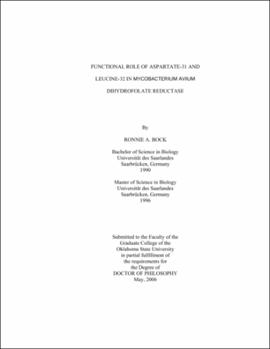| dc.contributor.advisor | Barrow, W. | |
| dc.contributor.author | Bock, Ronnie A | |
| dc.date.accessioned | 2013-11-26T08:35:13Z | |
| dc.date.available | 2013-11-26T08:35:13Z | |
| dc.date.issued | 2006-05 | |
| dc.identifier.uri | https://hdl.handle.net/11244/7652 | |
| dc.description.abstract | Scope and Method of Study: Dihydrofolate reductase (DHFR: 1.5.1.3) has long been a drug target in antibacterial therapy. However, DHFR of Mycobacterium avium and other mycobacteria are naturally resistant to trimethoprim and other antituberculous drugs. Recent reports show that a new class of drugs: 2,4-diaminodeazapteridine (DMDPs) are showing increased selectivity for Mycobacterium avium. Better understanding of the binding sites of M. avium DHFR, will contribute towards developing better and more effective drugs. Based on sequence alignments and X-ray crystal structures of other DHFR's, aspartic acid 31 (D31) and leucine 32 (L32) were identified as functionally important residues in interactions with the substrate dihydrofolate and inhibitors, respectively. D31 and L32 of M. avium DHFR were modified by site-directed mutagenesis (GeneEditor, Promega). to D31A, D31E, D31Q, D31N, D31L,. L32A, L32F and L32D. Mutations were verified by full length gene sequencing. These mutants were then expressed in E. coli BL21(DE3)pLysS and the recombinant mutant protein purified using HisBind-Resin (Novangen). Functionality of the mutants was assessed in comparison with the recombinant wild type by a standard enzyme assay as well as by growth complementation. Kinetic parameters were determined and computed using the non-linear curve fit program Enzfitter (BioSoft, UK). | |
| dc.description.abstract | Findings and Conclusions: All D31 mutations rendered the enzyme severely dysfunctional. Enzyme activity of the mutants D31E, D31Q and D31N were reduced by between 80 and 90%. Functionality of the mutants D31A and D31L were reduced by over 90% compared to the wild type. | |
| dc.description.abstract | All D31 mutants show differences in kinetics compared to the wild type. Of the L32 mutants, only L32D reduced the enzyme's activity by two-thirds and showed differences in kinetic behavior compared to the wild type. L32F and L32A did not show selectivity for trimethoprim, while L32D did. The DMDP inhibitors were highly effective against the wild type. The mutants showed differences in selectivity to the DMDPs. The findings support the hypotheses that D31 plays a functional role with the substrate and L32 plays a functional role with inhibitors. All D31 mutations studies resulted in a dysfunctional enzyme, regardless of changes in side chain size or charge. Modification of L32 led to increased selectivity for trimethoprim, but decreased selectivity for the DMDPs. | |
| dc.format | application/pdf | |
| dc.language | en_US | |
| dc.rights | Copyright is held by the author who has granted the Oklahoma State University Library the non-exclusive right to share this material in its institutional repository. Contact Digital Library Services at lib-dls@okstate.edu or 405-744-9161 for the permission policy on the use, reproduction or distribution of this material. | |
| dc.title | Functional role of aspartate-31 and leucine-32 in Mycobacterium avium dihydrofolate reductase | |
| dc.contributor.committeeMember | Malayer, J. | |
| dc.contributor.committeeMember | Clinkenbeard, K. | |
| dc.contributor.committeeMember | Burnap, R. | |
| osu.filename | Bock_okstate_0664D_1788.pdf | |
| osu.accesstype | Open Access | |
| dc.type.genre | Dissertation | |
| dc.type.material | Text | |
| thesis.degree.discipline | Veterinary Pathobiology | |
| thesis.degree.grantor | Oklahoma State University | |
